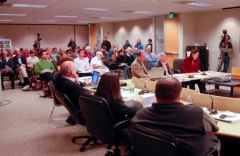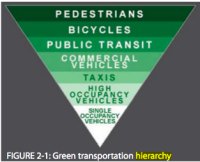
the hearing last night.
(Photos © J. Maus)
Last night in downtown Portland, the City’s Planning Commission heard three hours of testimony on the Portland Bicycle Plan for 2030. Despite a rumor that there would be “organized opposition” and that the plan would be in for a “bumpy night” and the scene would resemble the “unruly town halls on health care reform”, the night was actually quite tame.
Out of the entire three hours, there was only person — the infamous Terry Parker — who was in direct opposition to the plan (more on that below). A few others had solid critiques, but overall the plan received widespread support. In the end, the Commission decided to “hold open” the hearing until their next meeting on November 10th so they could “incorporate additional comment in the record” (according to Commissioner Chris Smith).
“When the number of trips made by bike outnumbers the number of trips made by car, we’ll know we’ve reached our goals.”
— Roger Geller, PBOT bike coordinator
(Read my live report from the hearing, and/or read below for a summary and further analysis.)
The hearing opened with an introduction from the Portland Bureau of Transportation’s (PBOT) Master Plan project manager Ellen Vanderslice who said the plan “articulates a transformative vision” for our city.
City bike coordinator Roger Geller than did a short presentation that focused more on aspiration than on wonky technical details. He illustrated Portland’s booming bike scene (from its culture to the economic impact) and said that “It has been the network that’s been at the foundation that everything has been built on.” Geller then laid out the chief strategy of the Plan:
“To advance, we need to reach out to the average people, the mainstream, people that ride not because they’re cyclists, but because it’s safe and comfortable… Our plan builds upon our bicycle legacy and will make bicycles a pillar of our city’s transportation system.”
“What is the better gateway drug to cycling, bike boulevards or off-street paths?”
— Chris Smith, planning commissioner
Geller also shared a few choice stats from the plan that definitely caught the attention of the Commissioners. Currently, he said, only 28% of Portlanders live within five blocks of a developed “low-stress” bikeway. Once the Tier One level of projects (a $100 million package that’s the first priority for the City) have been built out, that number will rise to 80%.
To put a finer point on the plan’s objectives, Geller said, “When the number of trips made by bike outnumbers the number of trips made by car, we’ll know we’ve reached our goals.”
“I don’t think it’s a question of either-or, we’d like to see it all.”
— Howard Shapiro, planning commissioner
Also lending official support to the plan were three members of the Master Plan Steering Committee: former City bike coordinator and now owner of a major planning firm Mia Birk, Bike Gallery owner Jay Graves, and representing the downtown business perspective, Randy Miller.

Birk focused on the “Green Transportation Hierarchy” concept that the plan intends to insert into City policy. That hierarchy would radically shift how the City approaches street designs, putting human-powered modes at the top and placing single-occupancy vehicles at the bottom. Graves said he’s excited about the plan because of how more trips by bike will mean less congestion as he drives his work truck around the city making deliveries between his six Portland-area stores. And Miller said Portland’s bike reputation is key in setting our city apart and can be a lucrative distinction for the business community.
As expected, trail advocates stepped up to share their concerns that the Plan focuses too much on the on-street network, at the expense of off-street path projects like the North Portland Greenway and Sullivan’s Gulch trails.
Adamski’s (and that of a Sullivan’s Gulch Trail committee member who read similar comments) testimony sparked dialogue from Commissioners Howard Shapiro and Chris Smith and marked what could become an important debate that shapes this Master Plan.
Trail advocates feel that the City’s strong focus on bicycle boulevards as a means to get more people on bikes, will not be as effective as a similar emphasis on large-scale, off-street path projects. Commissioner Smith said “This is a big issue for us” and he remarked how TriMet is taking just the opposite tact — by focusing on major MAX lines (off-street paths) over local service bus routes (bike boulevards). “What is the better gateway drug to cycling” he wondered, “Bike boulevards or off-street paths?”
Then it was Terry Parker’s turn. Parker is well-known for his disdain of pro-bike policies and bike projects. He said the plan is “one-sided”, that it’s outreach didn’t get beyond the “echo chamber of the bike community” and that the plan “treats bicyclists like elitists” that “expect expect mommy and daddy, in this case other taxpayers and motorists, to pay for the specialized infrastructure only they can use.”
The testimony that has gotten the most attention — including lead story treatment from KATU-TV last night — is that of Don Arambula, who was speaking on behalf of urban planning firm Crandall-Arambula. Arambula feels like the plan doesn’t go far enough and that its focus on shared, in-street facilities (bike boulevards) will not net the type of mode split he feels is possible in Portland. Arambula spoke in favor of more fully-separated facilities like cycle-tracks, which are ubiquitous in the cities with 35-40% bike usage rates Portland is trying to emulate.
“Portland will be lucky to get 10% [bike mode split] with [bike] boulevard approach. Protected bikeways are responsible for Copenhagen’s high bike ridership… Portland should be striving to become a world class bicycle city… The plan should clearly depict our city’s vision and should not be watered down by lack of current funding… a plan that doesn’t offer the best solution is a missed opportunity.”
Here’s KATU’s video coverage (featuring an interview with Arambula’s partner George Crandall):
Back in August, Arambula’s partner, George Crandall presented similar thoughts in a presentation to local bike insiders including BTA board members and staffers and members of Metro’s Executive Committee on Active Transportation.
Crandall’s vision — to create a network of fully-separated bikeways that reach key commercial centers — is an exciting one. However, PBOT plans to take a more pragmatic approach. To them, it’s a matter of budgetary constraints and political and public support, mixed with finding a strategy that has the best return on investment. To them, that is to build “developed bikeways” (which can mean a number of things, including bicycle boulevards) that will reach a large number of Portland residents.
PBOT feels that Portland does not yet have the public constituency that would give them the political cover to make the hard decisions necessary to create a large network of cycle tracks. Those decisions would include drastic makeovers of streets in commercial zones, removing parking throughout the city (which is known to rile feathers and also take meter revenue away from PBOT), including the Central Business District.
These are important issues that we’ll cover in the weeks and months to come.
Before last night’s hearing, Roger Geller said expected to “Hear it from both sides tonight… both from people who think we’re going too far, and others who think we’re not going far enough.” What happened is that he mostly heard from people in the middle.
The Planning Commission will make an official recommendation and vote on the Master Plan at their meeting on November 10th. From there, the plan must still be adopted by City Council in January. But the plan itself is just the opening salvo. The big question will be whether or not all the policy recommendations in it will be officially incorporated as binding City policy in much more powerful plans like the City’s Transportation System Plan and the over-arching Portland Plan.
Stay tuned.
— For full coverage of the Bicycle Master Plan/Portland Bicycle Plan for 2030, browse the 43 stories on it from our archives.

